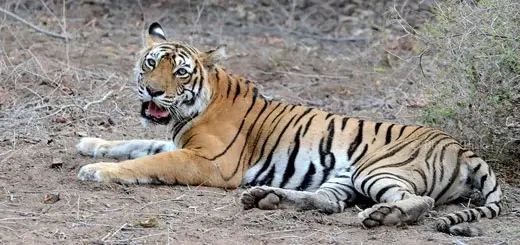
The Queen of the wildness of Ranthambore National Park, Machli was the most admired tigress in the world when was alive. She played a major role in the regeneration of tiger population in Ranthambore National Park and she was called by various names like Queen Mother of Tigers, Tigress Queen of Ranthambore, Lady of the Lakes, and crocodile Killer. Even after her death in August 2016, her esteem still continued to be alive in the wildlife reserve.
Lifetime Achievement of Machli
Machli was considered to have been the most photographed tigress in the world. She was also cast in innumerable wildlife documentaries. In addition to living such longer life than most other wild tigresses which usually top out around 15 years of age, she had achieved eminence since after defending a 14-foot crocodile against much larger male tigers. She won the “Lifetime Achievement Award” of Travel Operator for Tigers for her contribution to conservation and tourist attraction that contributed significantly to the Indian economy.
DNA report of a tigress
In a recent development, the legendary tigress all set for the technical immortality with the help of the advanced biotechnological methods. A team of genetic scientists, conservation biologists and forest officials of Ranthambore are all alliance together to start a process of creating a genetic map from the DNA of tigress Machli. The process was to trace out and ascertain the sequence of the genes from the DNA. At the time of death of Machli, her DNA was preserved for research.
The legendary tigress t-16, Machli was credited with reviving the endangered tiger population in Ranthambore and was the flag bearer of the save tiger project of the Indian government. More than half of the tiger population of Ranthambore and Sariska National Park in Rajasthan are the descendants of tigress Machli. She was the proud mother of 11 cubs and all these were divided into Sariska and Ranthambore National Park. She lived almost about 20 years and died in August 2016.
The CCMB (Centre for Cellular and Molecular Biology) based in Hyderabad has been declared to have progression the complete genome of an Indian Tiger which is for the very first time in India. Even today the reference genome of a tiger used for the study of Tiger genetics is that of a Siberian tiger named Amur. For the genome analysis of Machli, multiple technologies of genome-reading have been used to ensure the accuracy and an unparalleled level of detail.
Dr. Uma Ramakrishnan was leading the team who is responsible for the genome analysis of Machli’s DNA. She took a reference and stated where these genes are available, in what populations, how they are different. To determine a clear report various characteristics of a tiger such as the sense of smell, the strength, and metabolism have been developed in this species due to the presence of particular genes of Machli.
Once on the edge of extinction, the Royal Bengal Tiger population has been tremendously increased after the proper implementation of the conservation policies laid by the Indian Government. Now, India is a home of around three-fourths of the world population of Bengal Tigers in the wild with count rises from 1411 tigers in 2006 to about 2226 tigers in 2014.
The Lady of Lake: The Longest Running Tiger Dynasty
The pride of Ranathambore National Park’s most prestigious lake area, Machli at her very young age, claimed the throne from her mother by defeating her and ruled that area for 10 long years which was one of the longest-running tiger dynasties in the history. Thus she was also known as the Lady of the Lake.
Although we are human, we try hard to leave our marks in the world but success is not sure for everyone. Conversely, at least we can learn how to live a life of dignity from Machli.